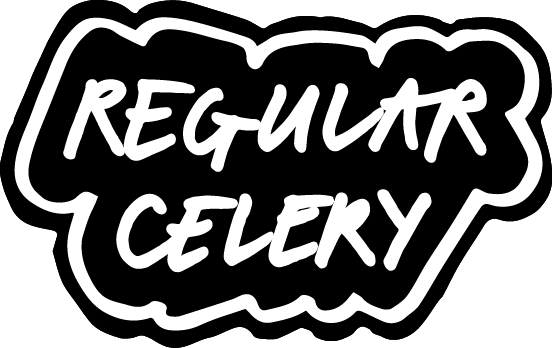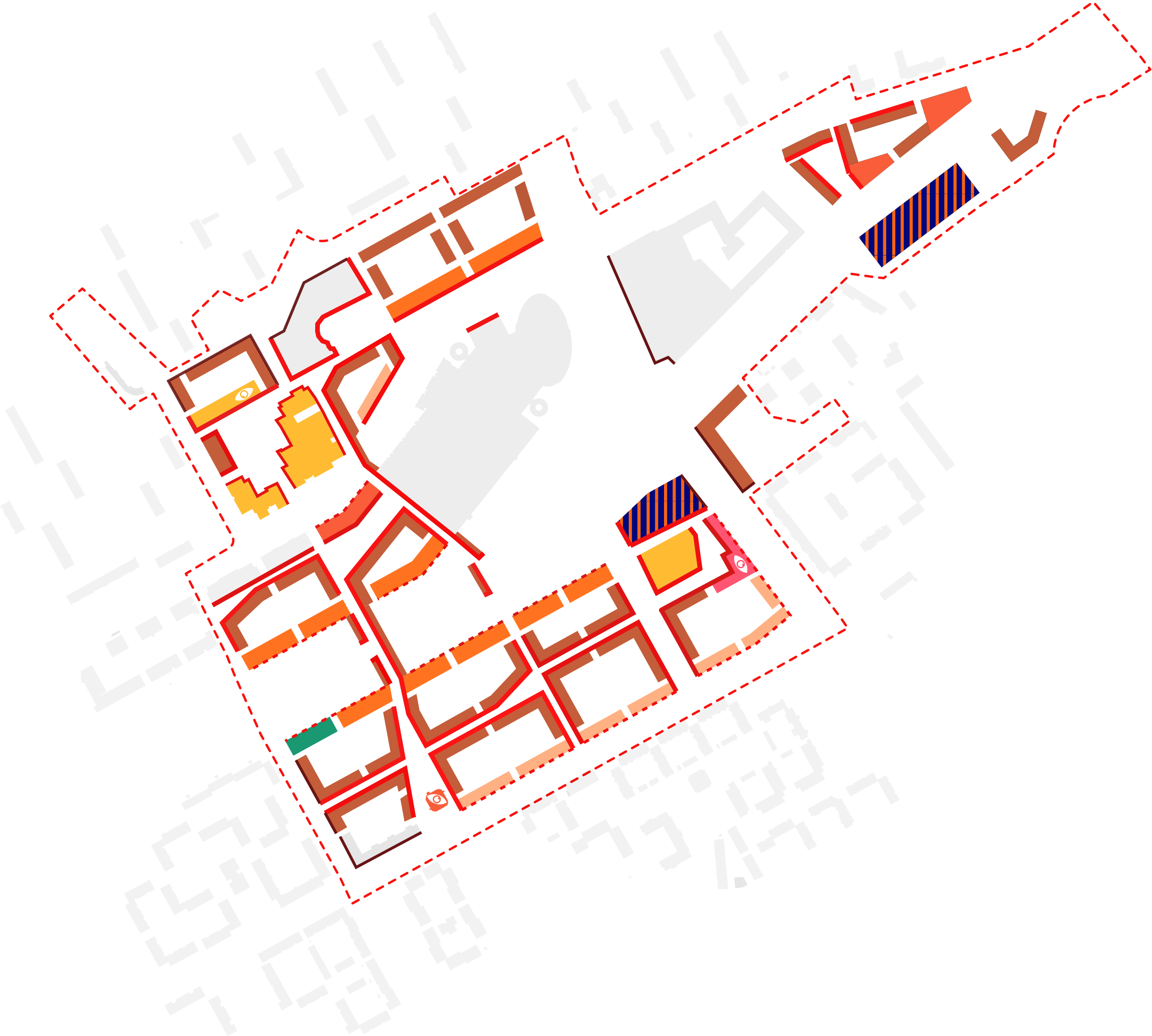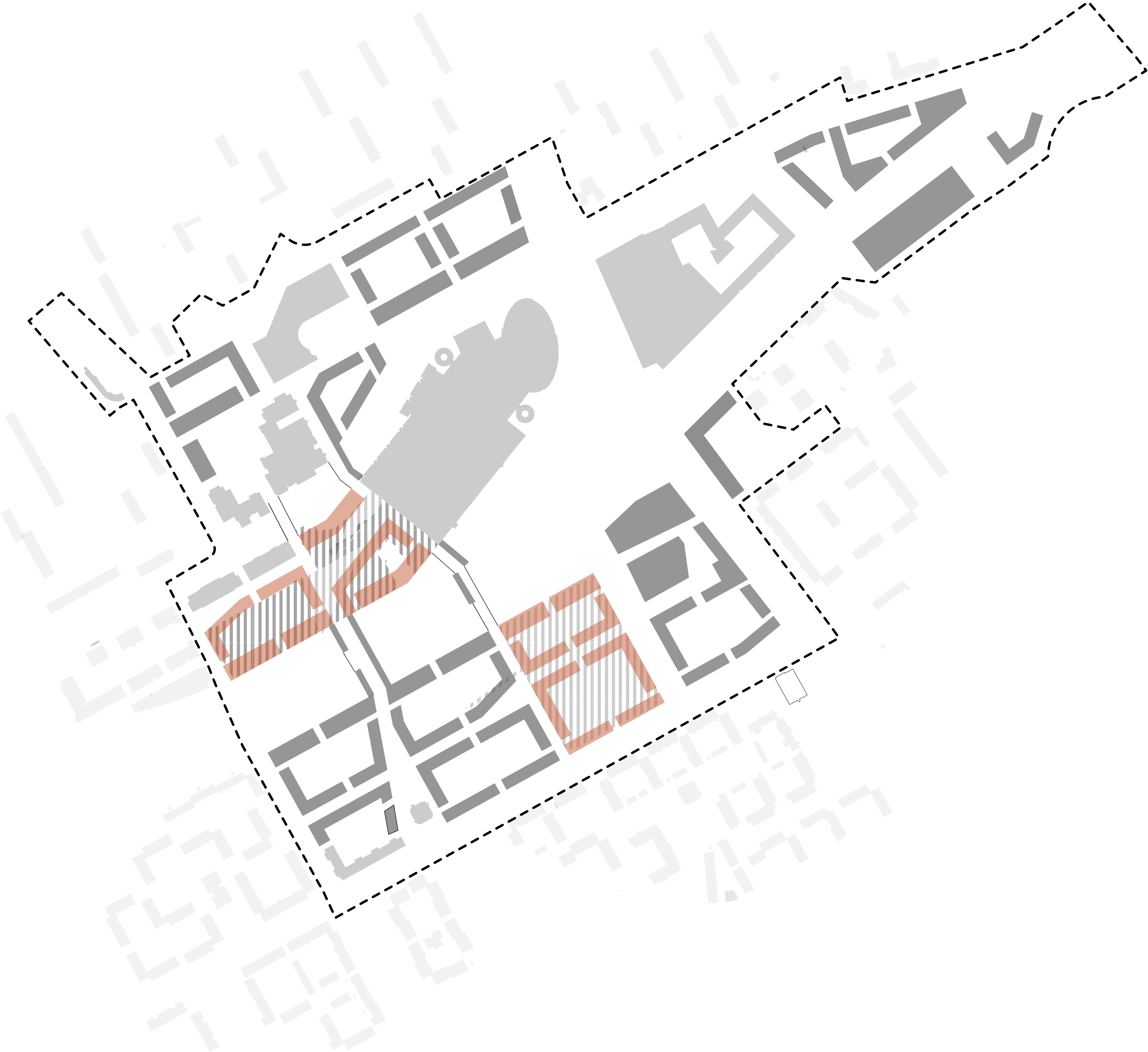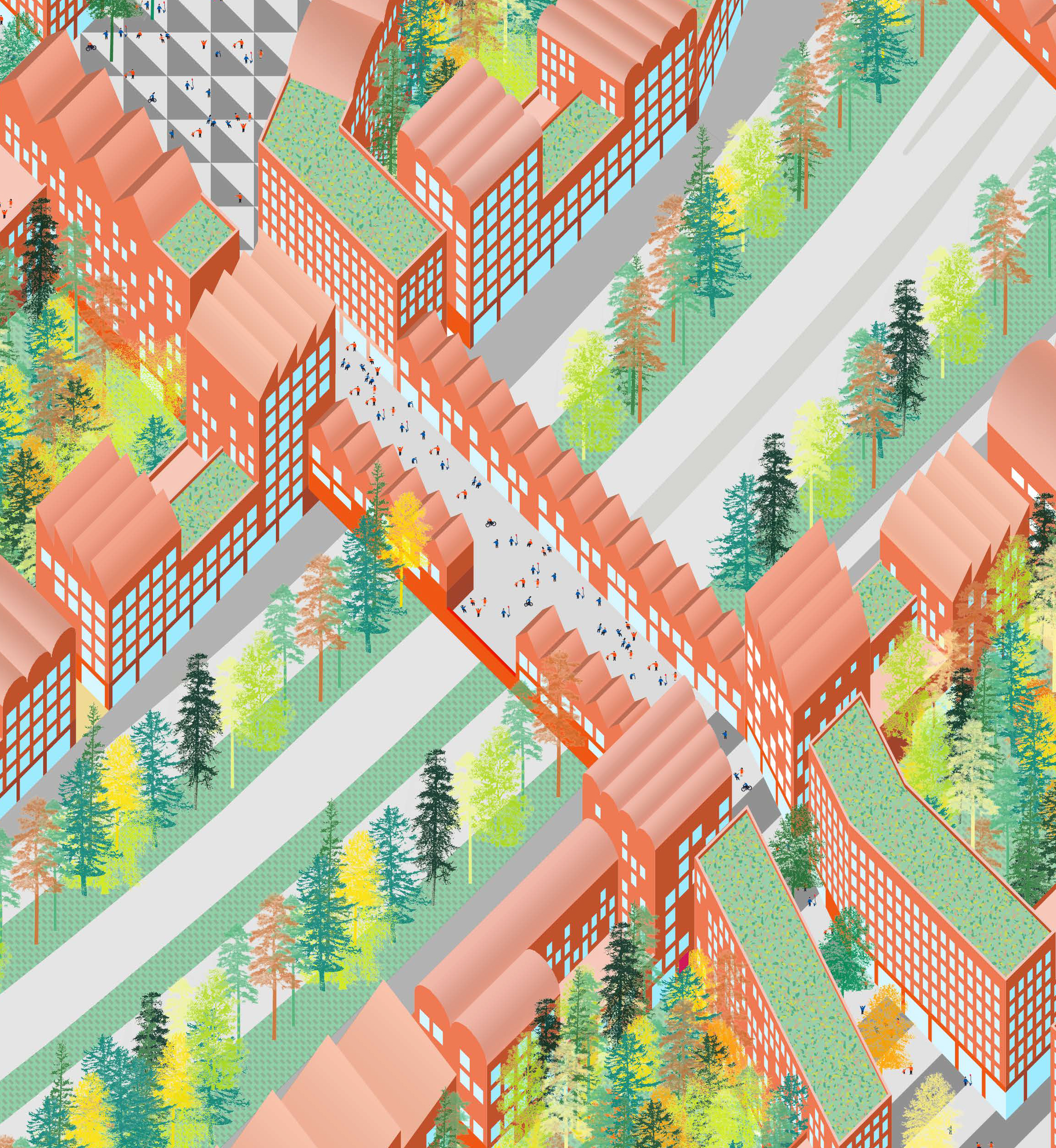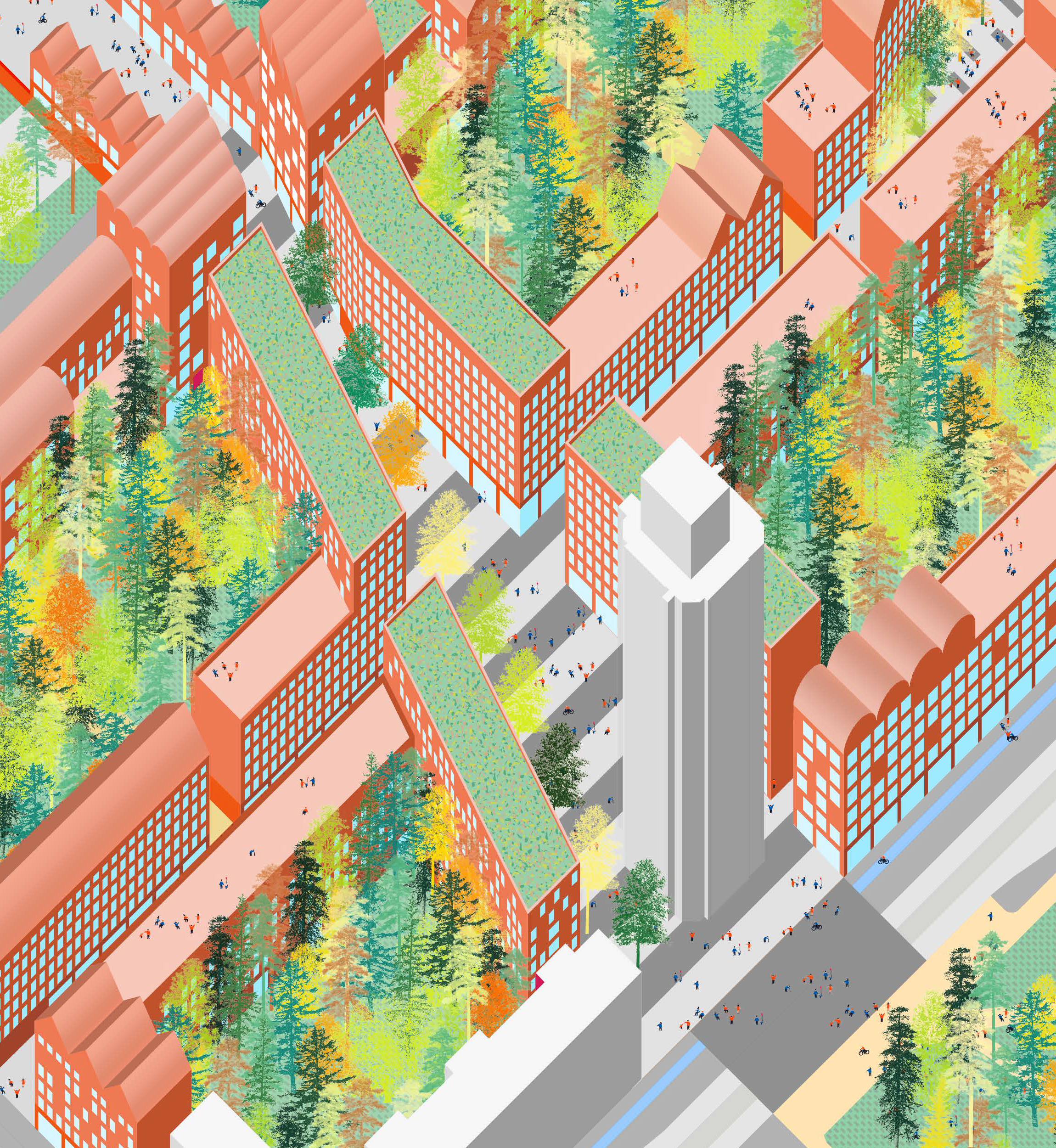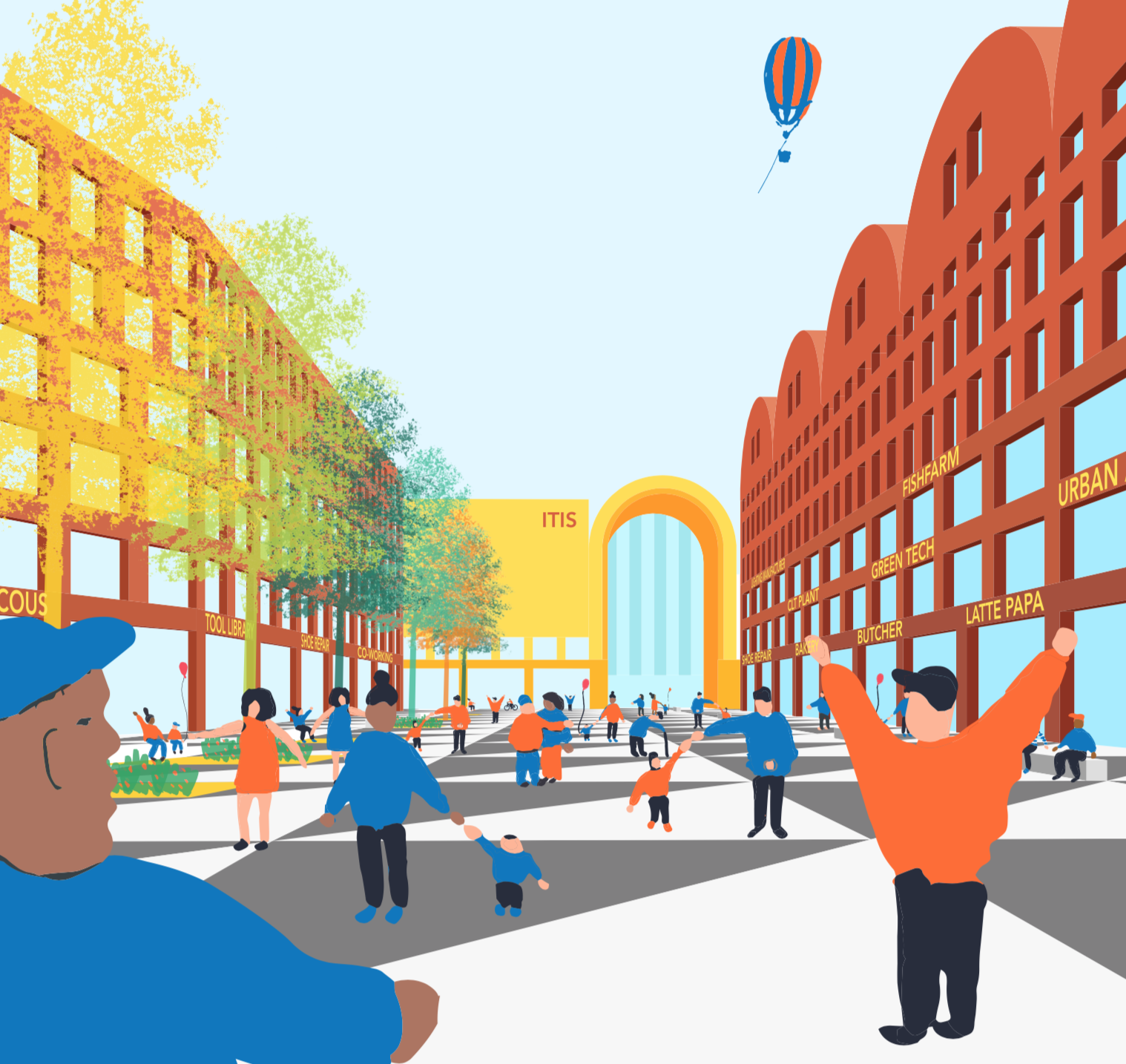Itäkeskus Urban Design
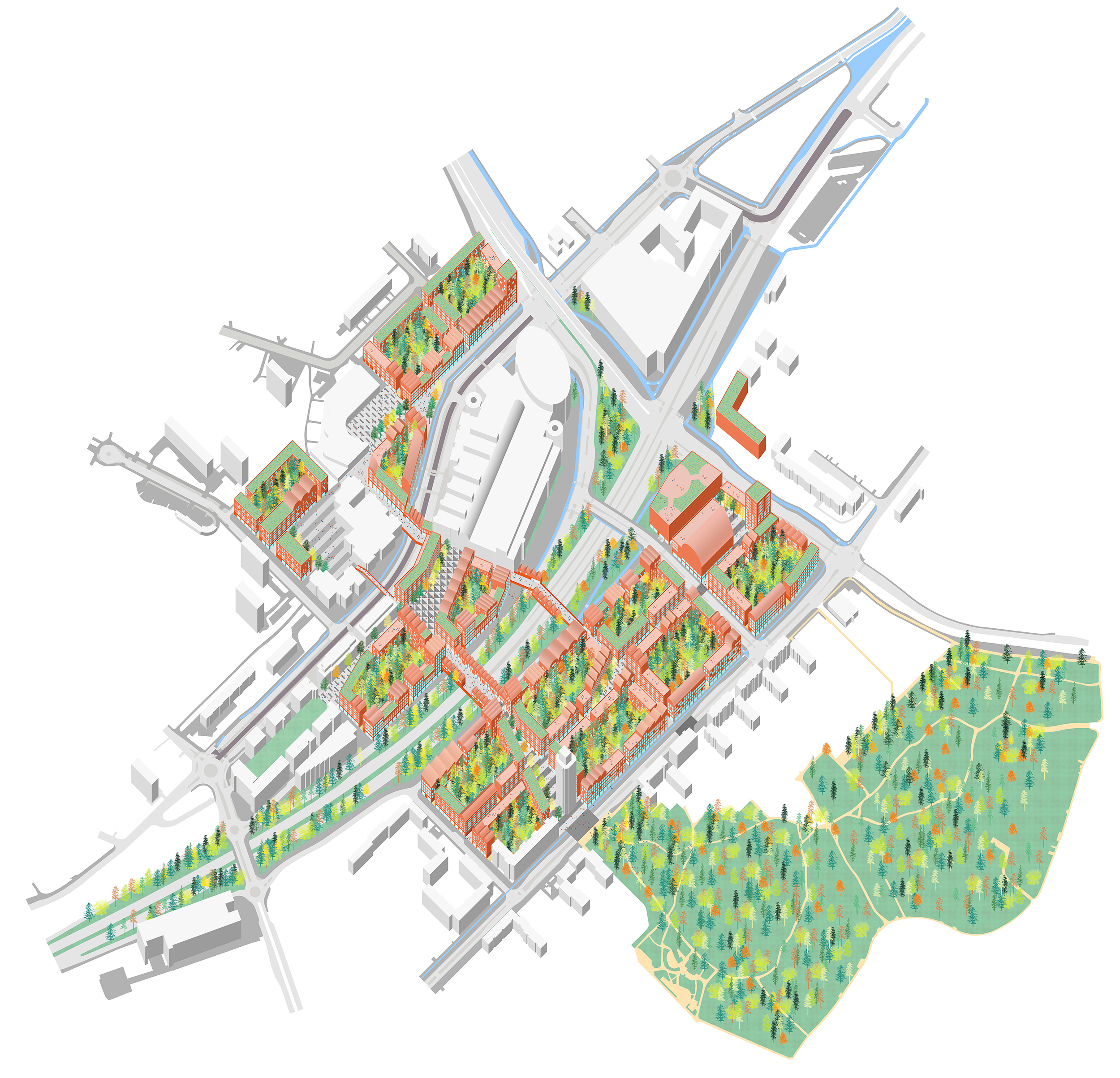
COMMONS is an ambitious proposal to transform Itakeskus into a thriving piece of city; a socially, environmentally and economically sustainable place with a dense urban character. The proposal aims to build upon the area’s present strengths – its cultural diversity and entrepreneurial spirit – to create a place that people will want to live, work and visit.
The full competition boards can be downloaded here: COMMONS
Urban strategy: An active and connected piece of city
Key to our strategy is the introduction of a dense urban structure to the site; providing a legible streetscape and lively public realm. A key North-South Route links the existing STOA Cultural Centre and 1960’s Puhos Shopping Centre to the north, to Ystavyyden Park in the south, creating a bustling ‘High Street’. This primary route is supplemented by a three new East – West axis which allow easy movement through the site on energetic urban streets. A series of carefully scaled new public spaces are proposed at places of exchange, each with different spatial qualities and programmatic potential.
Mixed Use Development
Existing and Proposed: Making barriers into opportunities
The brief states the city’s ambition to make the area a ‘centre’ with an ‘urban city structure’. At present, there are several barriers to this aim including the busy highways which splice the area into three ‘islands’ and the large shopping centres which block external movement, provide no active frontages and have a detrimental effect on streetscape and public realm.
We aim to reslove these issues through the proposal of phased construction, allowing shopping centres Itis and Easton to remain in their current configurations and link with the proposal until the time comes for redevelopment. At this point, we propose the demolition of the 1984 ‘Pasaasi’ portion of ITIS in order to complete the urban fabric and the recladding of the ‘Bulevardi’ portion of ITIS in order to link with the new public spaces.
We also propose the eventual demolition of Easton, due to its monolithic presence. The Easton site would be redeveloped into mixed-use blocks in order to provide considerably better urban spaces and provide a more varied income stream for the land-owner.
Our project aims to treat the highways as an opportunity rather than a barrier. We propose the creation of ‘Industrial Corridors’ at ground level along the highways; integrating local industry into the city centre fabric. The proposed industrial units will vary from 10m2 to 1000m2 and will have active frontages facing the street, which could be used for a showrooms, educational/visitor centres or outlets, and access to rough and ready working yards to the rear.
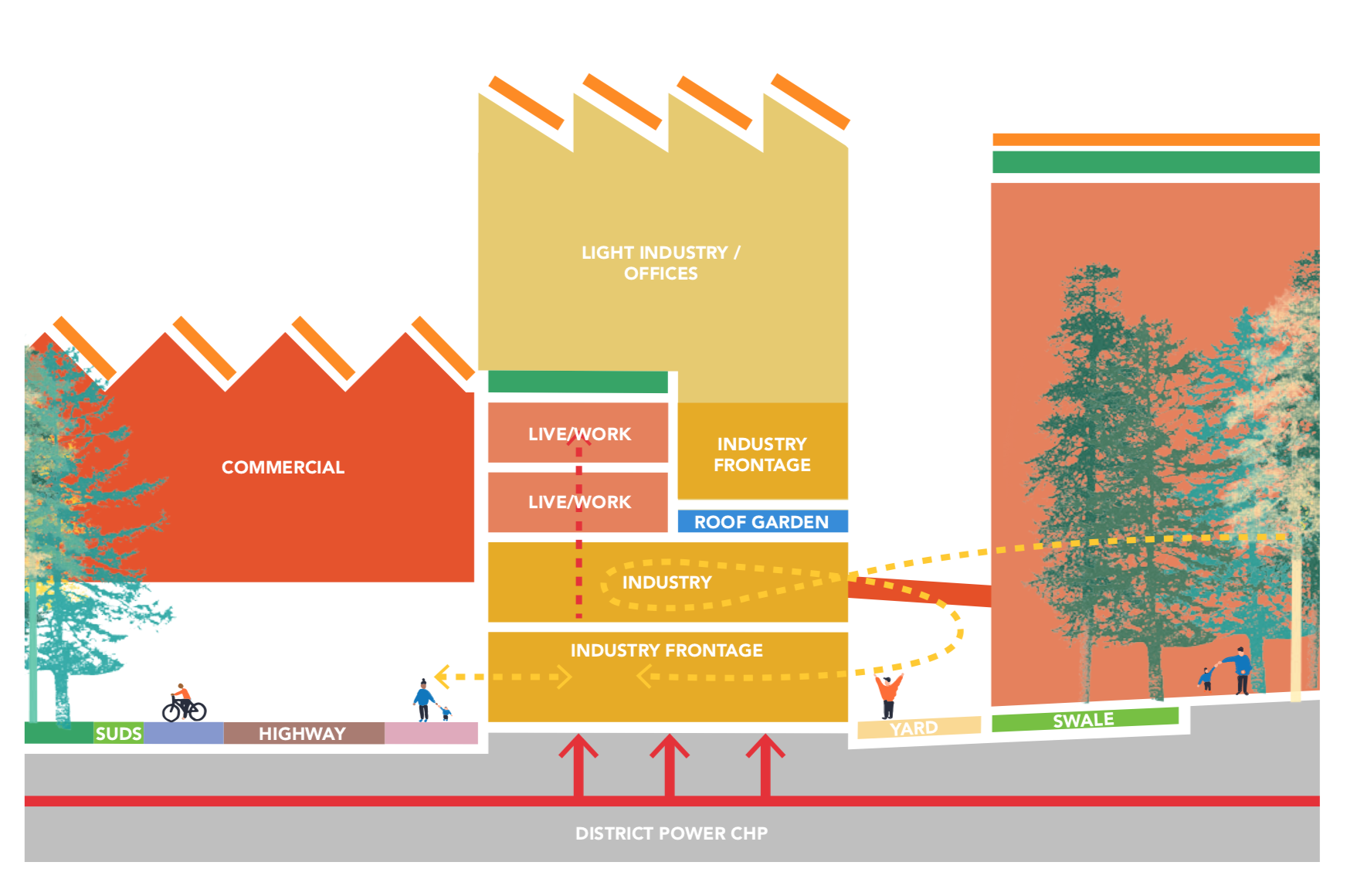
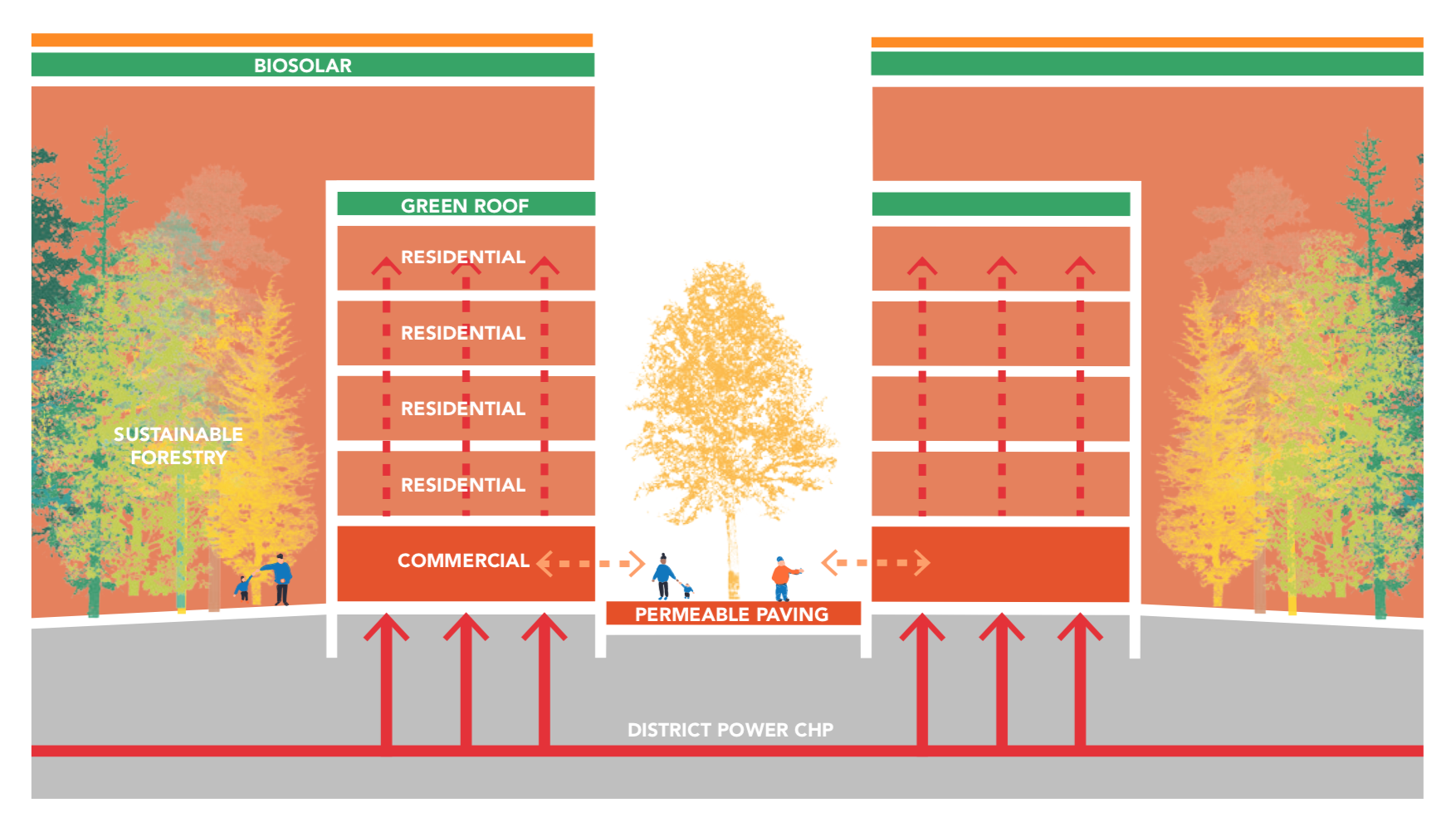
Circular Economy: Local Employment & Entrepreneurs
In recent years, Helsinki has worked hard to establish itself as the city of start-ups and we envisage that Itakeskus can become a hive of activity, with affordable rents and the provision of start-up grants allowing local people to make a wide range of businesses in the proposed industrial units, ground floor commercial units and offices, just as they have at present in the Puhos Shopping Centre. From green in- dustries such as Urban Farming to lawyers, artist and designers to specialist book binding, the advantages of these industries having a city centre presence is clear – local production, education opportunities and activation of city streets.
It is envisaged that the area can be full of local supply chains: a circular economy, manufacturing components and goods, providing services and purchase opportu- nities across a full range of sectors. For example, imagine getting an espresso at a local cafe whilst sitting on a chair milled from onsite timber in the space above; with a view down to an industrial entrepreneur using those coffee grounds to com- mercially grow Chanterelle mushrooms which are then sold in the market across the street and eaten at a dinner table above that. Our proposal aims to provide an environment which will foster a wide range of employment opportunities for local people. We believe that people should enjoy their work and this will help to keep young people in the area and attract new residents, ensuring the area prospers for generations.
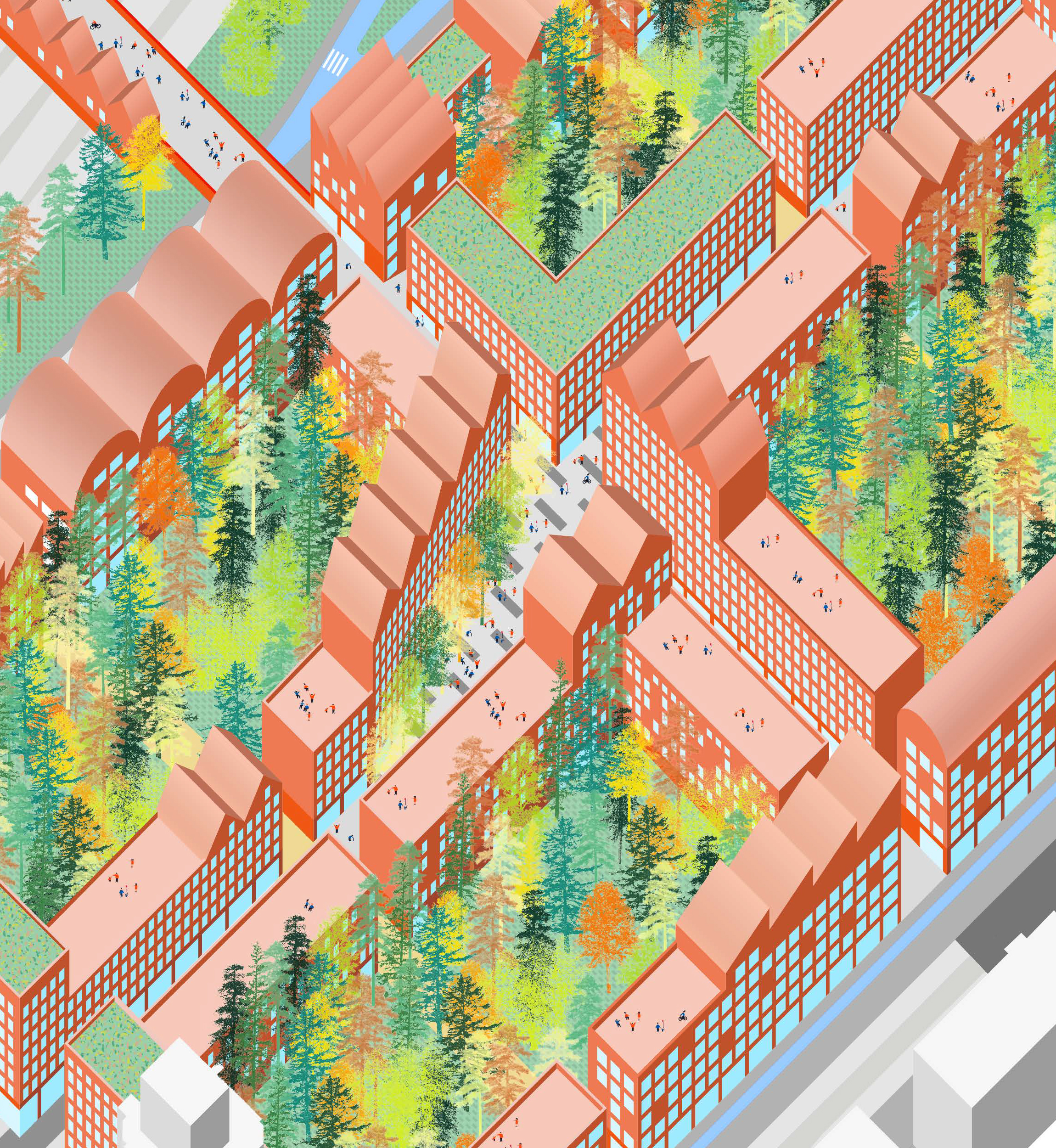
Urban Streets and Spaces:
An inviting public realm will be key to making Itakeskus successful. We are proposing a strong and legible series of streets and spaces with a clear hierarchy. Widths vary from 16 metres for the High Street to 6 metres for public paths through the courtyards. The surrounding buildings have been sensitively scaled to provide enclosure but be sympathetic to the existing context. These streets will have a lively daytime and evening economy with a mix of diverse uses and active frontages. We have worked hard to design a streetscape which is clear, but retains interest – has enough turns and variation to keep some mystery, whilst maintaining sight lines and ease of movement.
Tilted Ground:
The proposed north-south ‘High Street’ contains two inhabited bridges which are conceived as a seamless part of the continuous public realm. In order to achieve this, the north- south route is designed with areas of maximum 1:21 gradient in order to link the bridges to the street network without the need for additional ramps or stairs. All areas of the plan are fully accessible. The bridges are enlivened with ground floor commercial space and first floor office and/or light industrial spaces. It is envisaged that the bridges be filled with small independent businesses, making them destinations in their own right.
Public Spaces:
The proposal contains 5 main squares of different scales and purposes. These will be predominantly pedestrian, with vehicle access to service the commercial units.
5 smaller pocket squares are also proposed at key points in the urban fabric, such as the transition between Itakeskus Metro station and the proposed streets.
Public spaces will be a mix of hard and soft landscaping, and will be designed to give each area to have an individual character.
Puhos Square: Announces Puhos and hosts a market.
STOA Square: An events space with an informal atmosphere. Central Square: A large and formal city square.
Park Square: Gate to Ystavyyden Park with street-food market.
Theatre Square: A casual public space addressing the theatre and hotel; a welcome mat for visitors to the area.
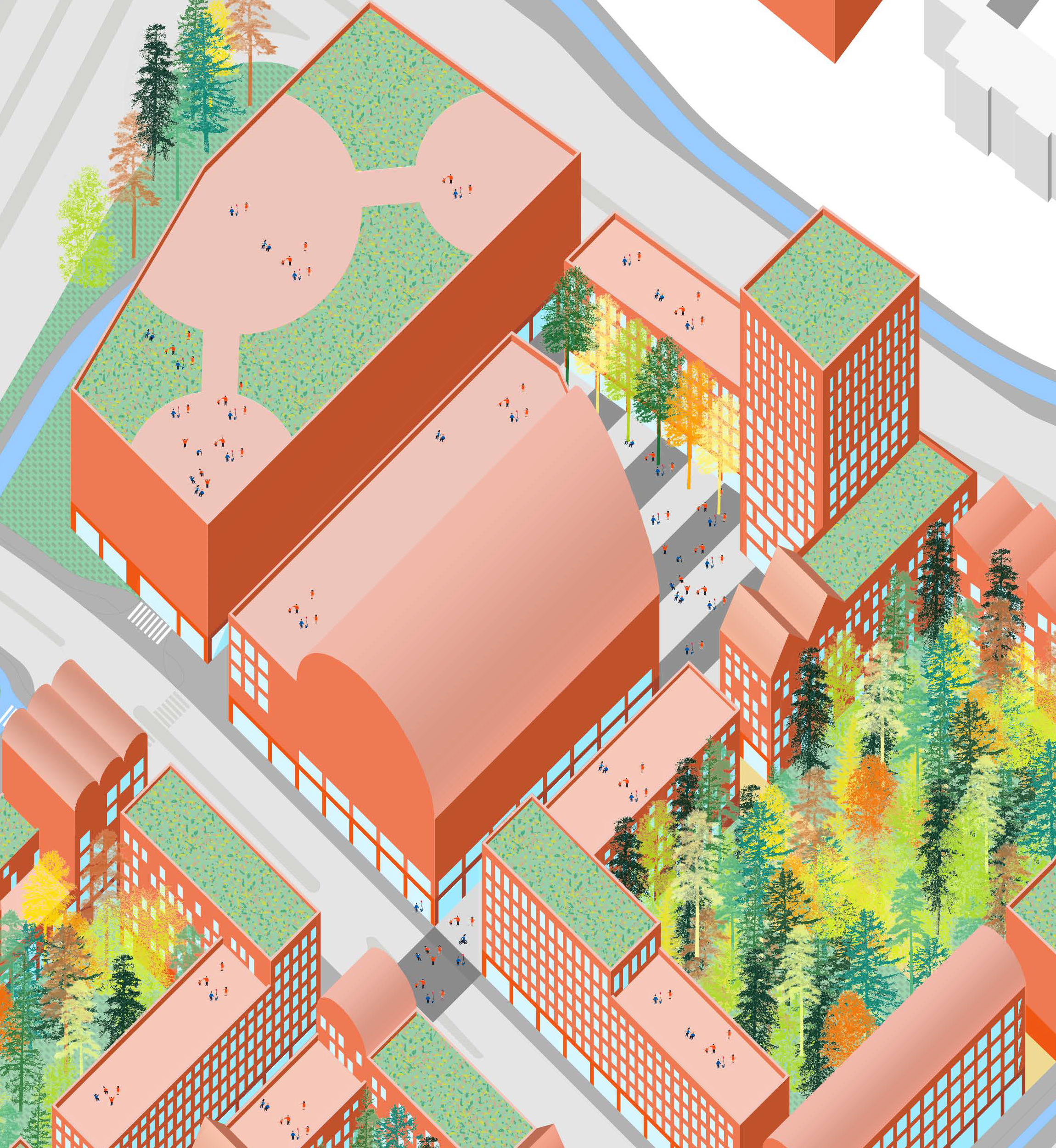
Homes for All:
Central to our proposal is higher density living, whilst retaining the access to nature that people living in Finland are accustomed to. Housing should be affordable. The proposed housing aims to be passive house – with dual aspect and clean air, and access to green views. There will be a variety of housing types including live/ work, maisonettes, flats and ground floor accessible homes. All homes will have the capacity to grow and change with the residents who live in them.
Sharing Culture:
At present, culture is integral to Itakeskus, the STOA Culture Centre is one of the best in Helsinki. Our proposal aims to build upon this by completing the enclosure of STOA Square and providing complementary cultural activities in a new building opposite the square. We are also proposing a Theatre/Events space to the South East of the site which will create two cultural anchors at either end of the urban fabric.
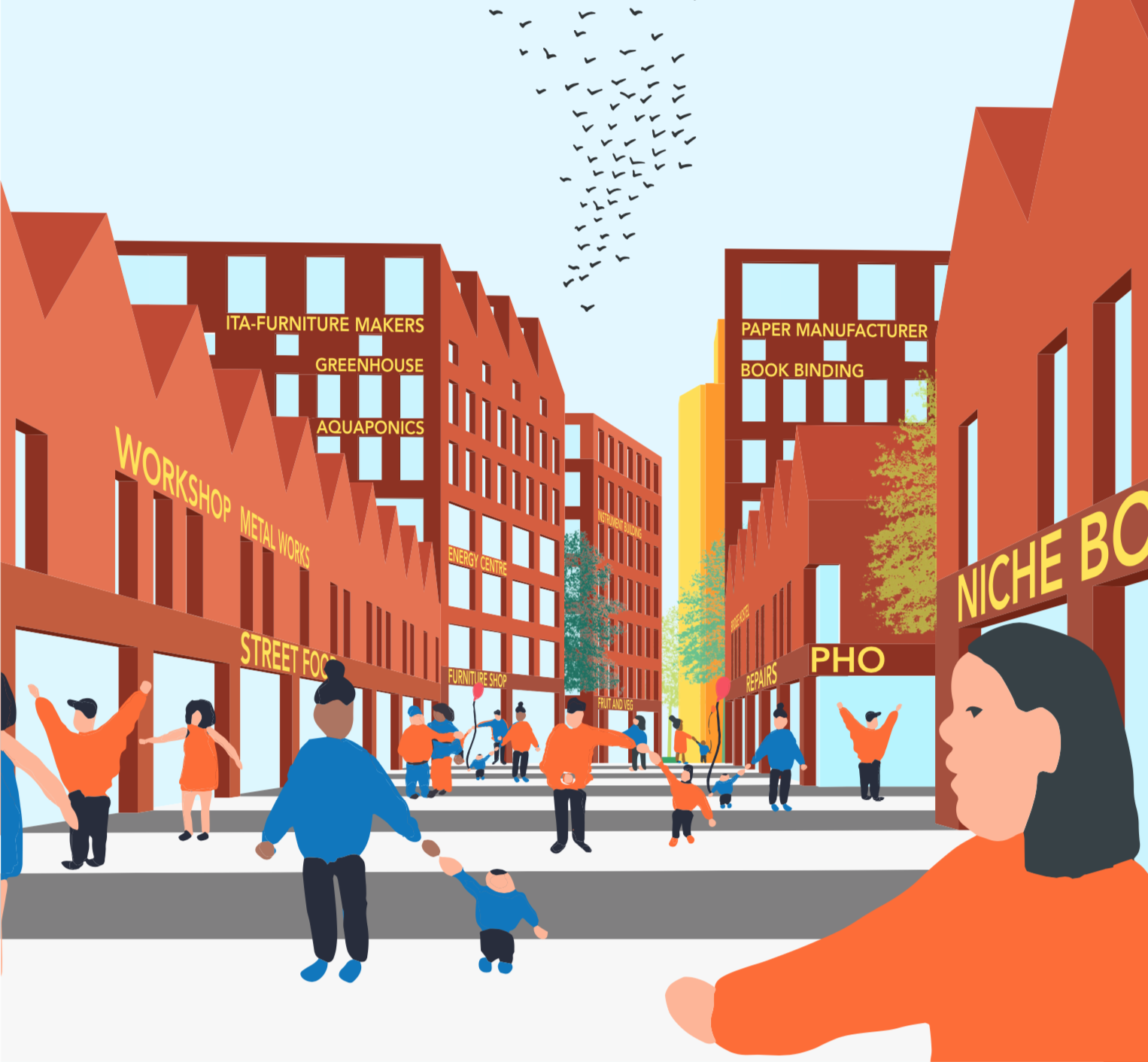
Sustainable Urbanism
The proposal aims to be an exemplar in terms of sustainable urbanism:
Renewable Energy:
Wherever possible, the scheme will utilise the concept of BioSOLAR by installing arrays of solar panels on top of a green roof structure.
Sustainable Urban Drainage Systems:
Stormwater runoff will be managed at source with a combination of pervious pavements, green roofs, walls, swales and rain gardens to intercept rainfall where it falls. Gullies and rainwater downpipes from existing buildings and highways will be disconnected from the sewer system and diverted into bioretention areas or swales to trap and treat pollutants. These SuDS features will introduce the multifunctional benefits of wetland biodiversity into the scheme.
District Heating Scheme:
An Energy Centre will be incorporated into an onsite building to utilise combined heat and power (CHP) technology to generate electricity and produce hot water. A network of insulated pipes will distribute heat to the surrounding commercial buildings and residential properties.
Utilising a singular energy source for the district removes the need for individual gas boilers creating a more efficient, economic and lower carbon energy solution. The Energy Centre could be fueled by sustainable sourced biomass such as woodchips from onsite forestry activities or biogas. Opportunities for the district heating scheme to supplemented by geothermal energy could be explored.
Sustainable Forestry:
A strategy of urban forestry has also been adopted in the scheme, with perimeter courtyard blocks enclosing 4.4 hectare of urban forests. The enclosed forests provide fantastic urban spaces and have great advantages for the well being of residents. In addition, trees will be planted in other areas across the site bringing the total area to 8.4 hectares. The forests will be managed using Continuous Cover Forestry techniques which creates a sustainable forest via the process of thinning.
A consistent quantity of thinned timber can be gathered from across the site (roughly 8m3/hectare/year), this can be used for a variety of applications, including use by sustainable industries such as CLT manufacturing or furniture making. Another option is to use the low quality timber for powering the CHP Energy Centre proposed on the site. For example, if the forestry onsite was supplemented by thinned timber from the nearby Sipoo National park, it would be possible to power the energy centre with a yearly supply of local renewable biomass.
